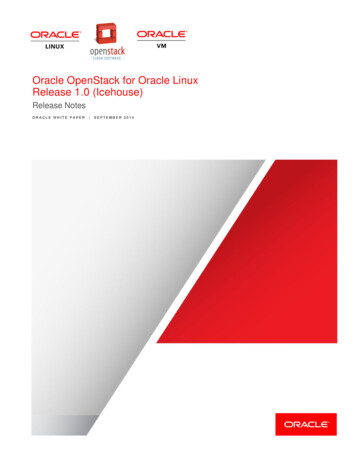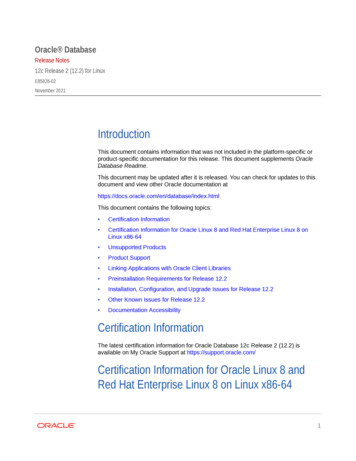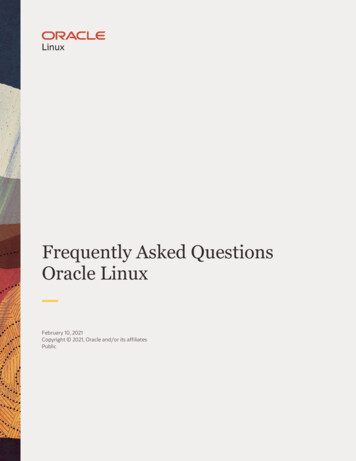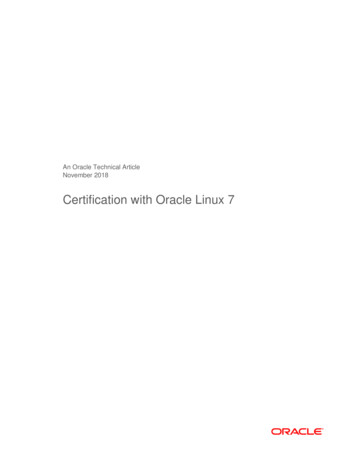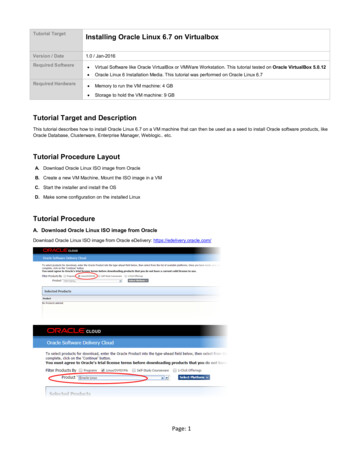
Transcription
Tutorial TargetInstalling Oracle Linux 6.7 on VirtualboxVersion / Date1.0 / Jan-2016Required SoftwareRequired Hardware Virtual Software like Oracle VirtualBox or VMWare Workstation. This tutorial tested on Oracle VirtualBox 5.0.12 Oracle Linux 6 Installation Media. This tutorial was performed on Oracle Linux 6.7 Memory to run the VM machine: 4 GB Storage to hold the VM machine: 9 GBTutorial Target and DescriptionThis tutorial describes how to install Oracle Linux 6.7 on a VM machine that can then be used as a seed to install Oracle software products, likeOracle Database, Clusterware, Enterprise Manager, Weblogic. etc.Tutorial Procedure LayoutA. Download Oracle Linux ISO image from OracleB. Create a new VM Machine, Mount the ISO image in a VMC. Start the installer and install the OSD. Make some configuration on the installed LinuxTutorial ProcedureA. Download Oracle Linux ISO image from OracleDownload Oracle Linux ISO image from Oracle eDelivery: https://edelivery.oracle.com/Page: 1
Click ContinueClick on Select Alternative ReleaseSelect Linux 6.7 and click ContinueAccept the Terms and Download.B. Create a new VM Machine, Mount the ISO image in a VM and start the installerDefine in the default location of your new VM machine in the settings:Create a new VM in an Expert Mode:Page: 2
Make some changes on the settings:Page: 3
Select the ISO file.Click StartPage: 4
C. start the installer and install the OSTip: right CTL to release mouse from the VMSelect Language NextBasic Storage NextClick Discard Any Data buttonPage: 5
Select the regionEnter root passwordPage: 6
Click NextPage: 7
Page: 8
After reboot, Click on ForwardPage: 9
Tip: to turn the auto-scale windows of the VM machine on and off, use the hotkey hostKey C.D. Make some configuration on the installed LinuxCheck oracle user is there:Page: 10
Set secure Linux to permissiveedit /etc/selinux/config file and set SELINUX permissiveTo apply changes, restart the server or execute the following command:setenforce permissiveDisable firewallservice iptables stopchkconfig iptables offCreate oracle base directory:mkdir -p /u01/app/oracle/productchown -R oracle:oinstall /u01chmod -R 775 /u01Create a user and grant it privileges (optional)useradd -m -n orauserpasswd orauser# Let’s make that user also belong to “dba” group:usermod -g users -G dba orauser# allow users belongs to “dba” group switching to an oracle account (this will open vi for you):visudo# add the following line to make dba group members execute any command by any user:%dba ALL (ALL) ALL# to allow it to switch to oracle only, add the following instead:%dba ALL /bin/su - oracle, !/bin/su *root*To test that:sudo su – oracleInstall Guest Additions in the VM machineGuest Additions won’t work if you install it immediately after performing the steps above. It requires “kernel source”.To install it through yum, perform the following:wget http://public-yum.oracle.com/public-yum-ol6.repo# the following installed 277MB in my test and took about 15 minutes to finish:yum updatePage: 11
# this will actually be installed by the “yum update” command. I just run it to confirm it is there:yum install kernel-uek-develIF all went good with you, mount the Guest Additions CD image to start installing them, as shown below:After installation, restart the box.You will notice that the mouse pointer will be captured by the VM machine once you hover the pointer anywhere inside the VM window. Youdon’t have click inside it.Page: 12
Also, these Additions will allow you to share files between your host machine and VM machine.Page: 13
This tutorial describes how to install Oracle Linux 6.7 on a VM machine that can then be used as a seed to install Oracle software products, like Oracle Database, Clusterware, Enterprise Manager, Weblogic. etc. Tutorial Procedure Layout A. Download Oracle Linux ISO image from Oracle B. Create a new VM Machine, Mount the ISO image in a VM

